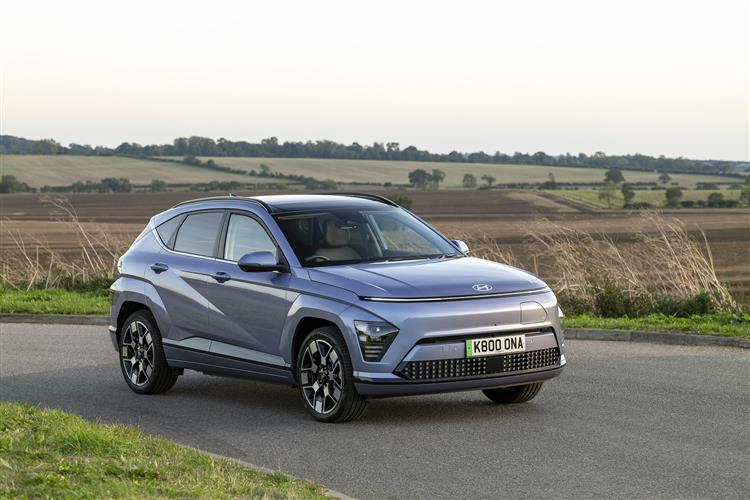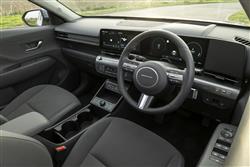TRAFFIC KONE (some text hidden) SECTIONED_new_hyundaikonaelectric_2024
By Jonathan Crouch
The second generation Hyundai Kona Electric small SUV is a big step forward from the first. Jonathan Crouch drives it.
Ten Second Reviewword count: 73
Contrary perhaps to appearances, Hyundai's second generation Kona Electric is a very different proposition to its predecessor. And contrary perhaps to expectations, it's also quite different to its close Hyundai Motor Group cousin, the car you might expect it to merely clone, the Kia Niro EV. In short, as far as it can, this larger, smarter, more sophisticated MK2 Kona Electric wants to set itself apart in the segment for compact EV Crossovers.
Backgroundword count: 217
Hyundai didn't invent the mainstream EV market but back in 2018, it introduced one of the two models usually credited with popularising it, the Kona Electric. That first generation version, updated in 2020, was a clone of the other key EV of the time, the similarly-sized Kia e-Niro, a fellow Hyundai Group model that shared all the same engineering. Like that full-battery Niro, the original Kona Electric was a derivative of the combustion model. This second generation Kona Electric though, is now the design core around which entire Kona range is these days based. Hybrid versions still exist: but they'll be out-sold by this full-battery variant this time round - in ever-increasing numbers. Even the old EV model accounted for four in every ten Konas sold in Europe, so hopes are high for this 'upscaled' MK2 version. Hyundai says the car was developed based on lessons learnt from their larger avant-garde IONIQ 5 and IONIQ 6 EVs, though unfortunately, it doesn't get the advanced ultra-rapid charging 800V electrical architecture that sets those two models apart in their respective segments. This is because the new K3 platform this second generation Kona Electric runs on (shared with the current Niro EV) wasn't developed for that. Much else about this car though, is satisfyingly avant-garde. Let's take a closer look.
Driving Experienceword count: 293
Though this second generation Kona Electric shares its new K3 platform with its close cousin and nearest class rival, the Kia Niro EV, surprisingly it doesn't share that car's electric motor and battery system. The differences aren't huge mind you: a 65.4kWh battery (0.6kWh bigger than the one in the Kia) and an electric motor with 214bhp (it's 201bhp in the Niro EV). But it's enough to make acceleration feel a tad more urgent. And crucially, for the driving range to be raised to a class-leading 319 miles with 17-inch wheels (36 miles more than the Niro EV). If you don't need to go that far between charges, Hyundai also offers the Kona Electric with a smaller 48.4kWh battery, a feebler 154bhp electric motor and a reduced range of 212 miles. With both versions, a standard heat pump should preserve those range figures in really cold weather. 0-62mph in the 65.4kWh version takes 7.8s en route to 107mph. As with the combustion mild hybrid and full-Hybrid Kona variants, you can expect a big refinement improvement thanks to the sleek aerodynamics and lessons Hyundai says it's learned from the slippery IONIQ 6. And this improvement is matched by a higher standard of ride quality, which is supple and aided by the stiffer platform with its greater use of high-strength steels. Hyundai has developed a new version of its 'i-Pedal' system, which allows selectable amounts of brake energy recuperation via steering wheel-mounted paddles. With the highest level of brake regen selected ('Max i-PEDAL'), the car will slow very noticeably off-throttle, almost down to a stop. There's a 'N Line' trim package available, but Hyundai says it has no plans for a full high-performance N version like the one it's developed for the larger IONIQ 5.
To see the full road test text contact us on 0330 0020 227
Pictures (high res disabled)

.jpg)
|
.jpg)
|
.jpg)
| |||
.jpg)
|
.jpg)
|
.jpg)
| |||
.jpg)
|
.jpg)
|

|
Statistics (subset of data only)
Min |
Max |
|
Price: |
£35,000.00 (At 24 Mar 2023, est) |
£42,000.00 (At 24 Mar 2023, est) |
Max Speed (mph): |
103 (est) |
|
0-62 mph (s): |
7.5 |
|
Electric WLTP-Rated Driving Range (miles): |
304 |
|
Length (mm): |
4355 |
|
Width (mm): |
1825 |
|
Height (mm): |
1585 |
|
Boot Capacity (l): |
460 |
|
Scoring (subset of scores)
Category: Hybrid, Plug-in, Electric & Hydrogen
| Performance | |
| Handling | |
| Comfort | |
| Space | |
| Styling, Build, Value, Equipment, Depreciation, Handling, Insurance and Total scores are available with our full data feed. | |



